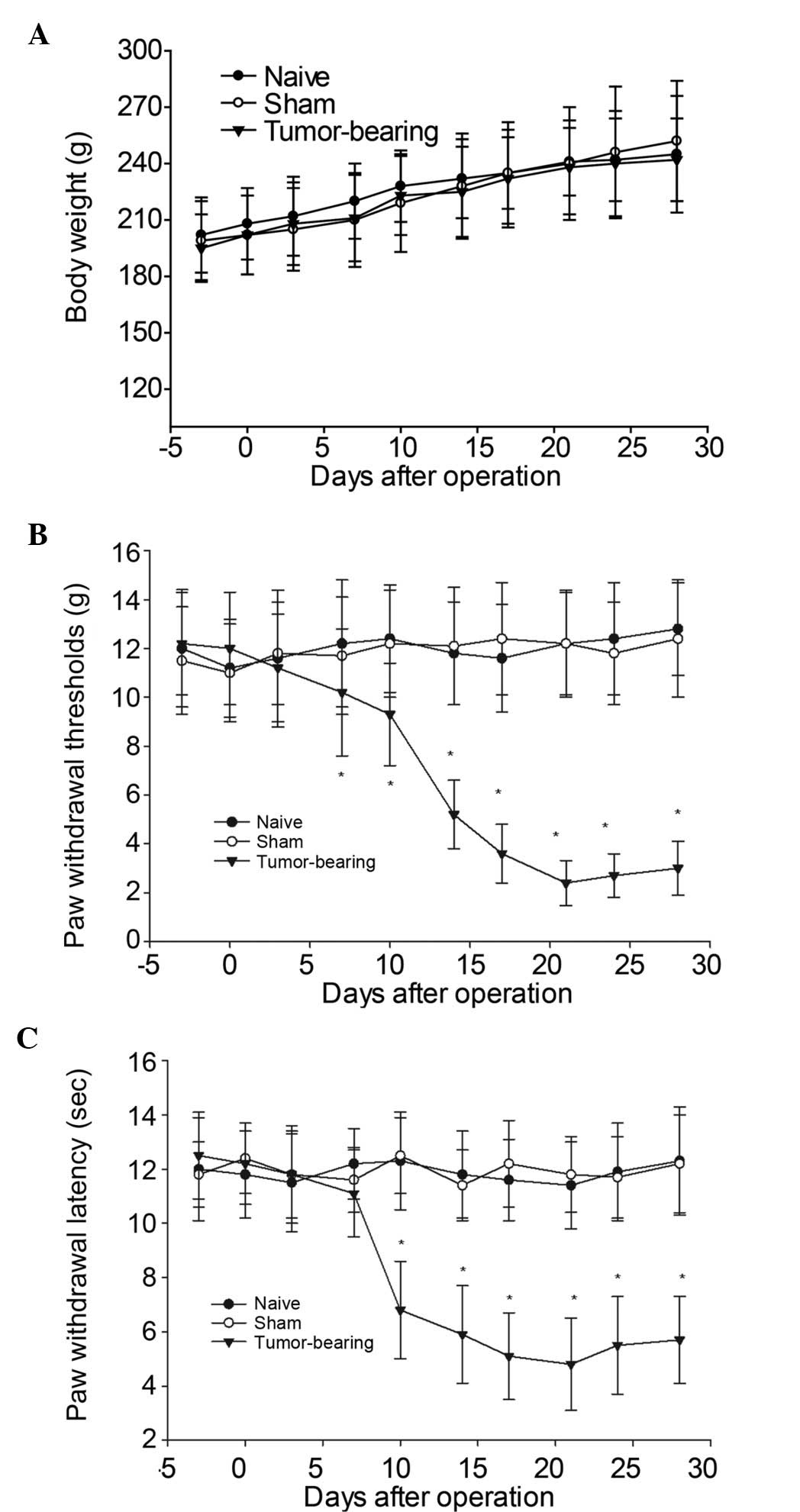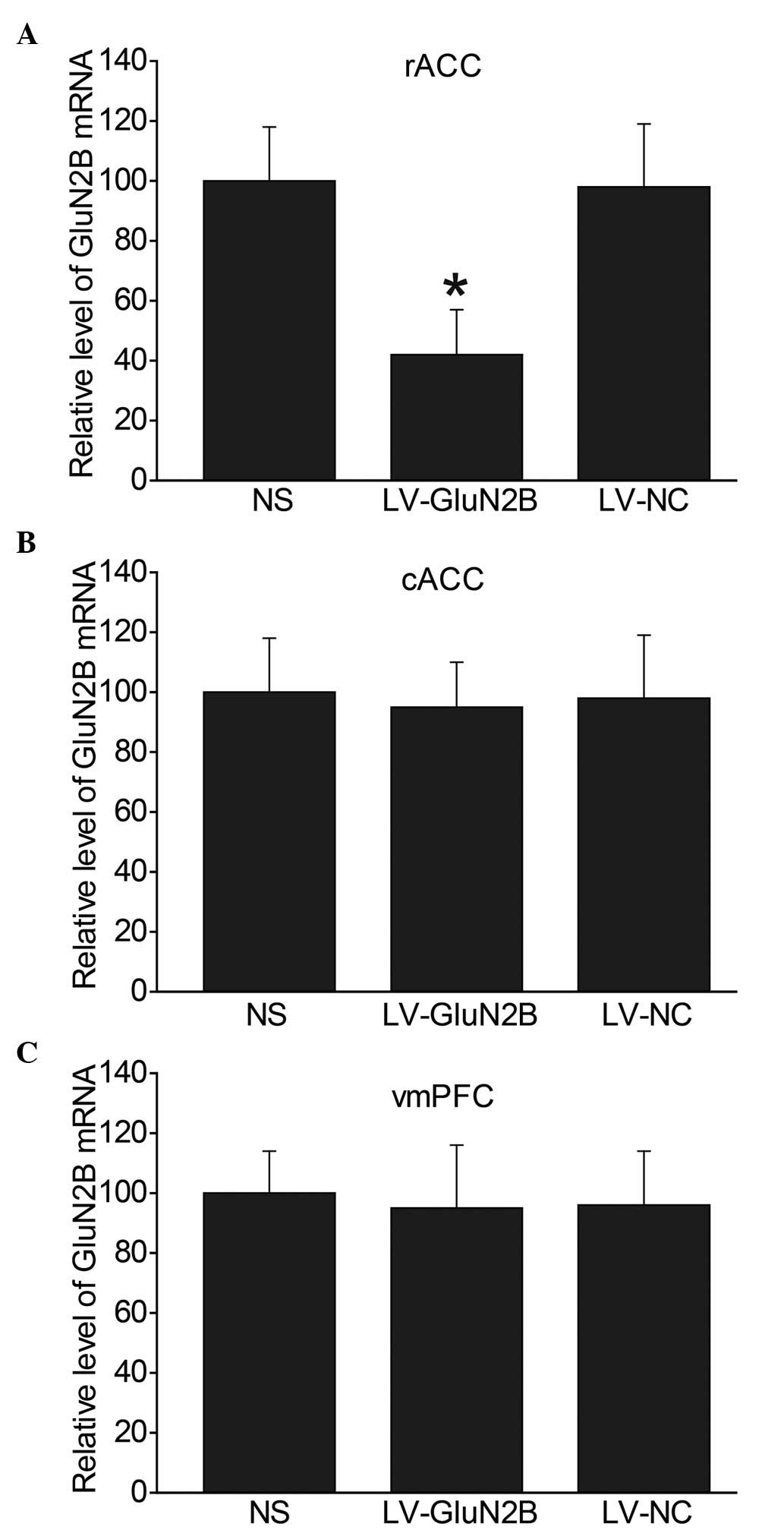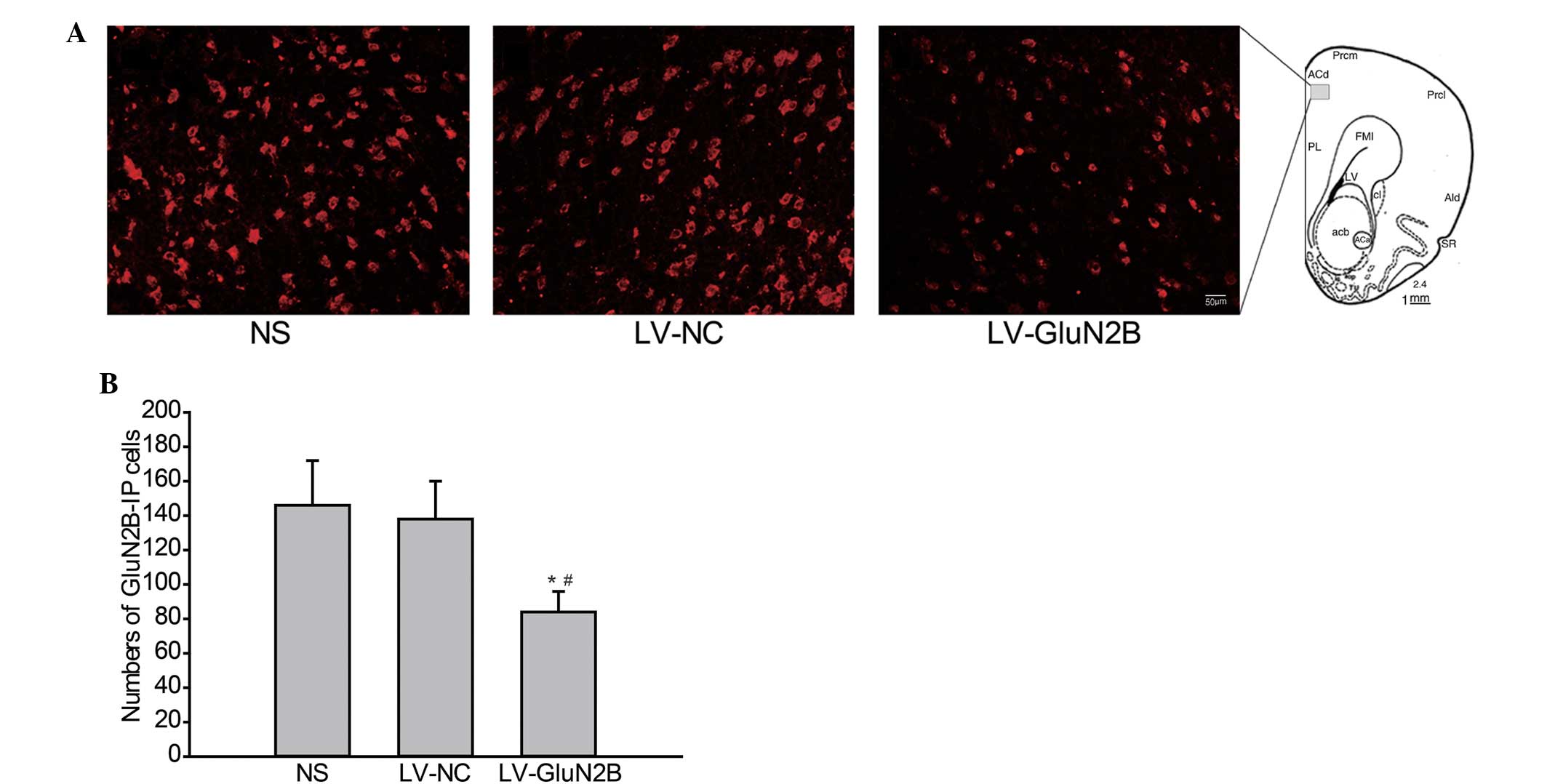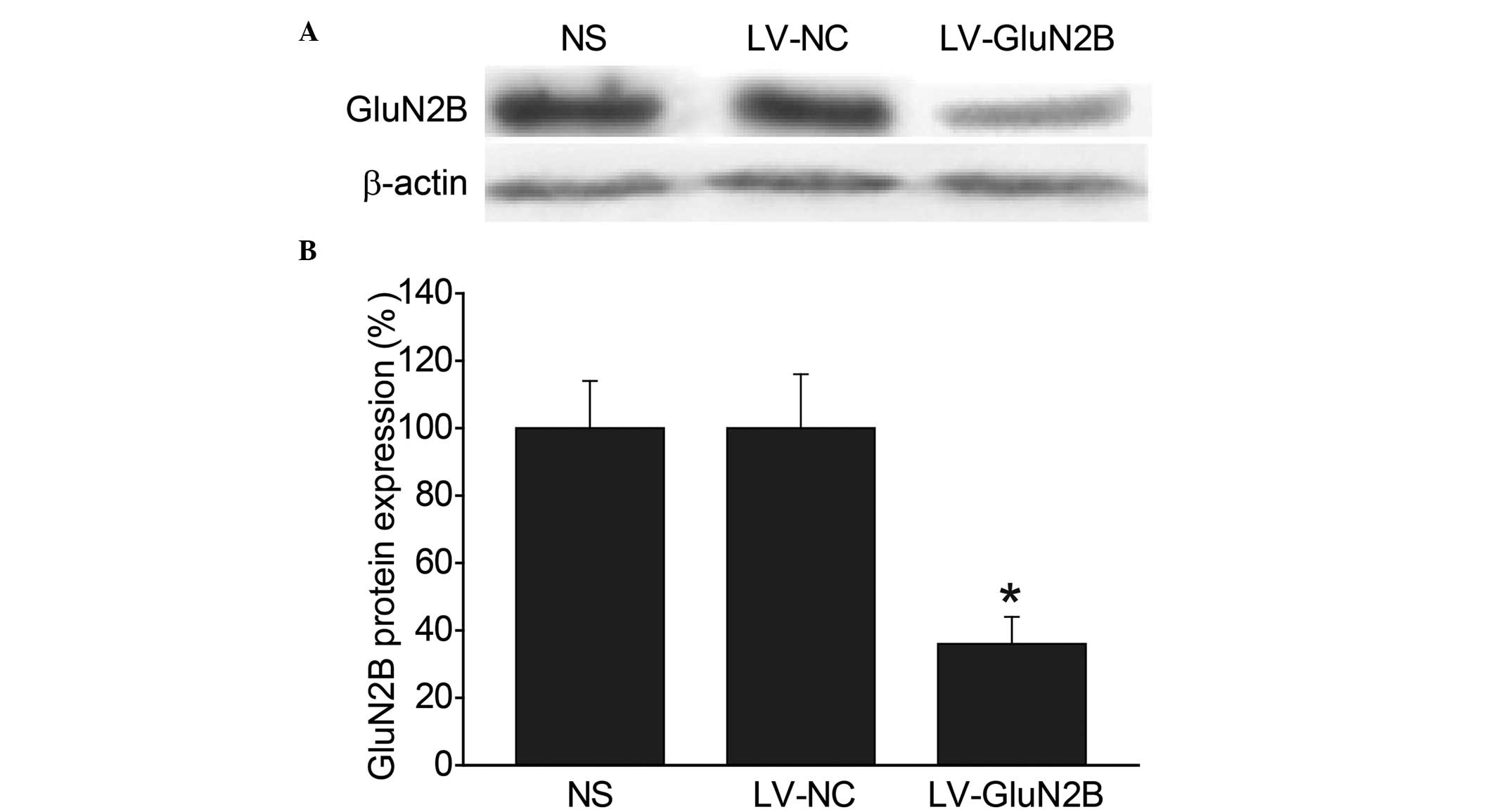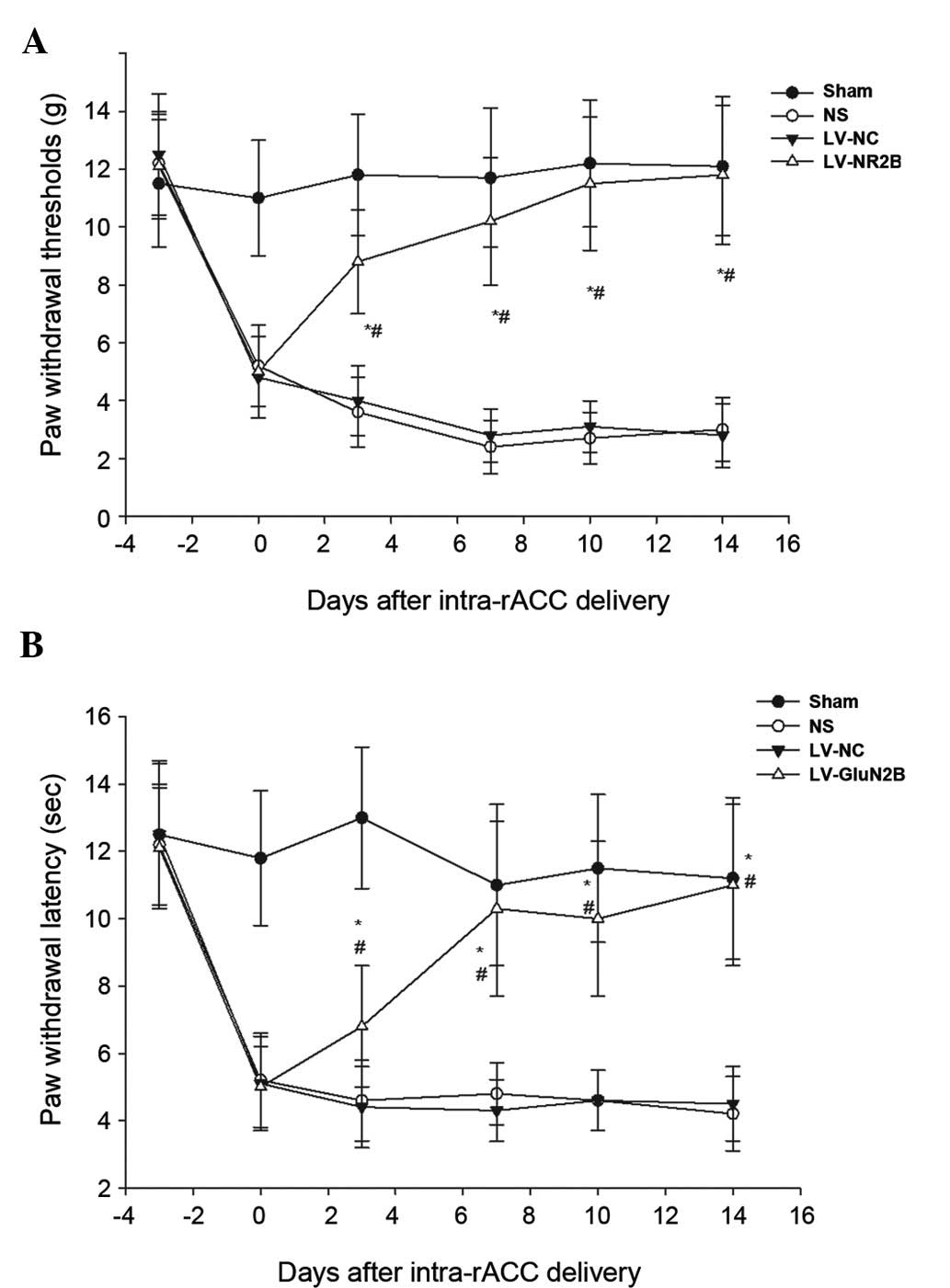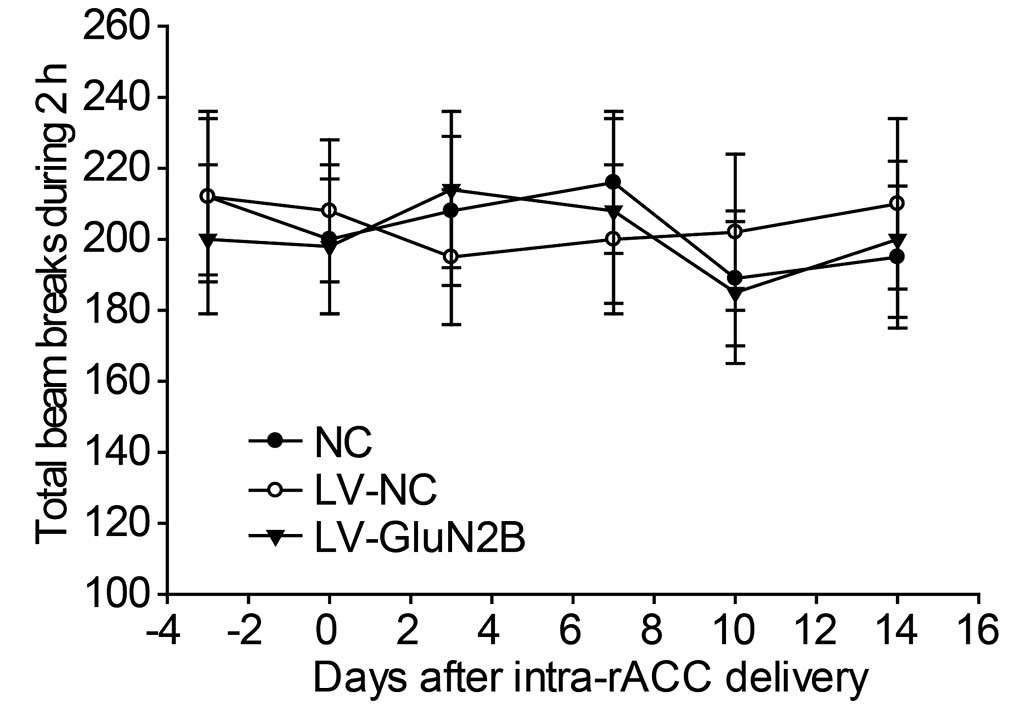|
1
|
Peng WL, Wu GJ, Sun WZ, Chen JC and Huang
AT: Multidisciplinary management of cancer pain: A longitudinal
retrospective study on a cohort of end-stage cancer patients. J
Pain Symptom Manage. 32:444–452. 2006. View Article : Google Scholar : PubMed/NCBI
|
|
2
|
Kuner R: Central mechanisms of
pathological pain. Nat Med. 16:1258–1266. 2010. View Article : Google Scholar : PubMed/NCBI
|
|
3
|
Price DD: Psychological and neural
mechanisms of the affective dimension of pain. Science.
288:1769–1772. 2000. View Article : Google Scholar : PubMed/NCBI
|
|
4
|
Pastoriza LN, Morrow TJ and Casey KL:
Medial frontal cortex lesions selectively attenuate the hot plate
response: Possible nocifensive apraxia in the rat. Pain. 64:11–17.
1996. View Article : Google Scholar : PubMed/NCBI
|
|
5
|
Vogt BA: Pain and emotion interactions in
subregions of the cingulate gyrus. Nat Rev Neurosci. 6:533–544.
2005. View
Article : Google Scholar : PubMed/NCBI
|
|
6
|
Zhuo M: Cortical excitation and chronic
pain. Trends Neurosci. 31:199–207. 2008. View Article : Google Scholar : PubMed/NCBI
|
|
7
|
Xu H, Wu LJ, Wang H, Zhang X, Vadakkan KI,
Kim SS, Steenland HW and Zhuo M: Presynaptic and postsynaptic
amplifications of neuropathic pain in the anterior cingulate
cortex. J Neurosci. 28:7445–7453. 2008. View Article : Google Scholar : PubMed/NCBI
|
|
8
|
Bie B, Brown DL and Naguib M: Increased
synaptic GluR1 subunits in the anterior cingulate cortex of rats
with peripheral inflammation. Eur J Pharmacol. 653:26–31. 2011.
View Article : Google Scholar : PubMed/NCBI
|
|
9
|
Wei F, Qiu CS, Kim SJ, Muglia L, Maas JW,
Pineda VV, Xu HM, Chen ZF, Storm DR, Muglia LJ and Zhuo M: Genetic
elimination of behavioral sensitization in mice lacking
calmodulin-stimulated adenylyl cyclases. Neuron. 36:713–726. 2002.
View Article : Google Scholar : PubMed/NCBI
|
|
10
|
Tang YP, Shimizu E, Dube GR, Rampon C,
Kerchner GA, Zhuo M, Liu G and Tsien JZ: Genetic enhancement of
learning and memory in mice. Nature. 401:63–69. 1999. View Article : Google Scholar : PubMed/NCBI
|
|
11
|
Wu LJ, Toyoda H, Zhao MG, Lee YS, Tang J,
Ko SW, Jia YH, Shum FW, Zerbinatti CV, Bu G, et al: Upregulation of
forebrain NMDA NR2B receptors contributes to behavioral
sensitization after inflammation. J Neurosci. 25:11107–111016.
2005. View Article : Google Scholar : PubMed/NCBI
|
|
12
|
Wei F, Wang GD, Kerchner GA, Kim SJ, Xu
HM, Chen ZF and Zhuo M: Genetic enhancement of inflammatory pain by
forebrain NR2B overexpression. Nat Neurosci. 4:164–169. 2001.
View Article : Google Scholar : PubMed/NCBI
|
|
13
|
Fire A, Xu S, Montgomery MK, Kostas SA,
Driver SE and Mello CC: Potent and specific genetic interference by
double-stranded RNA in Caenorhabditis elegans. Nature.
391:806–811. 1998. View
Article : Google Scholar : PubMed/NCBI
|
|
14
|
Dorn G, Patel S, Wotherspoon G,
Hemmings-Mieszczak M, Barclay J, Natt FJ, Martin P, Bevan S, Fox A,
Ganju P, et al: siRNA relieves chronic neuropathic pain. Nucleic
Acids Res. 32:e492004. View Article : Google Scholar : PubMed/NCBI
|
|
15
|
Naldini L, Blömer U, Gallay P, Ory D,
Mulligan R, Gage FH, Verma IM and Trono D: In vivo gene delivery
and stable transduction of nondividing cells by a lentiviral
vector. Science. 272:263–267. 1996. View Article : Google Scholar : PubMed/NCBI
|
|
16
|
Manjunath N, Wu H, Subramanya S and
Shankar P: Lentiviral delivery of short hairpin RNAs. Adv Drug
Deliv Rev. 61:732–745. 2009. View Article : Google Scholar : PubMed/NCBI
|
|
17
|
Coleman JE, Huentelman MJ, Kasparov S,
Metcalfe BL, Paton JF, Katovich MJ, Semple-Rowland SL and Raizada
MK: Efficient large-scale production and concentration of
HIV-1-based lentiviral vectors for use in vivo. Physiol Genomics.
12:221–228. 2003. View Article : Google Scholar : PubMed/NCBI
|
|
18
|
Déglon N, Tseng JL, Bensadoun JC, Zurn AD,
Arsenijevic Y, de Almeida Pereira L, Zufferey R, Trono D and
Aebischer P: Self-inactivating lentiviral vectors with enhanced
transgene expression as potential gene transfer system in
Parkinson's disease. Hum Gene Ther. 11:179–190. 2000. View Article : Google Scholar : PubMed/NCBI
|
|
19
|
Schwei MJ, Honore P, Rogers SD,
Salak-Johnson JL, Finke MP, Ramnaraine ML, Clohisy DR and Mantyh
PW: Neurochemical and cellular reorganization of the spinal cord in
a murine model of bone cancer pain. J Neurosci. 19:10886–10897.
1999.PubMed/NCBI
|
|
20
|
Paxinos G, Watson CR and Emson PC:
AChE-stained horizontal sections of the rat brain in stereotaxic
coordinates. J Neurosci Methods. 3:129–149. 1980. View Article : Google Scholar : PubMed/NCBI
|
|
21
|
Livak KJ and Schmittgen TD: Aanlysis of
relative gene expression data using real-time quantitative PCR and
2(−Delta Delta C(T)) Method. Methods. 25:402–408. 2001. View Article : Google Scholar : PubMed/NCBI
|
|
22
|
Chaplan SR, Bach FW, Pogrel JW, Chung JM
and Yaksh TL: Quantitative assessment of tactile allodynia in the
rat paw. J Neurosci Methods. 53:55–63. 1994. View Article : Google Scholar : PubMed/NCBI
|
|
23
|
Hargreaves K, Dubner R, Brown F, Flores C
and Joris J: A new and sensitive method for measuring thermal
nociception in cutaneous hyperalgesia. Pain. 32:77–88. 1988.
View Article : Google Scholar : PubMed/NCBI
|
|
24
|
Wacnik PW, Eikmeier LJ, Ruggles TR,
Ramnaraine ML, Walcheck BK, Beitz AJ and Wilcox GL: Functional
interactions between tumor and peripheral nerve: Morphology,
algogen identification, and behavioral characterization of a new
murine model of cancer pain. J Neurosci. 21:9355–9366.
2001.PubMed/NCBI
|
|
25
|
Zhai Z, Sooksa-nguan T and Vatamaniuk OK:
Establishing RNA interference as a reverse-genetic approach for
gene functional analysis in protoplasts. Plant Physiol.
149:642–652. 2009. View Article : Google Scholar : PubMed/NCBI
|
|
26
|
Shrey K, Suchit A, Nishant M and Vibha R:
RNA interference: Emerging diagnostics and therapeutics tool.
Biochem Biophys Res Commun. 386:273–277. 2009. View Article : Google Scholar : PubMed/NCBI
|
|
27
|
Franich NR, Fitzsimons HL, Fong DM,
Klugmann M, During MJ and Young D: AAV vector-mediated RNAi of
mutant huntingtin expression is neuroprotective in a novel genetic
rat model of Huntington's disease. Mol Ther. 16:947–956. 2008.
View Article : Google Scholar : PubMed/NCBI
|
|
28
|
Anesti AM, Peeters PJ, Royaux I and Coffin
RS: Efficient delivery of RNA interference to peripheral neurons in
vivo using herpes simplex virus. Nucleic Acids Res. 36:e862008.
View Article : Google Scholar : PubMed/NCBI
|
|
29
|
Calejesan AA, Kim SJ and Zhuo M:
Descending facilitatory modulation of a behavioral nociceptive
response by stimulation in the adult rat anterior cingulate cortex.
Eur J Pain. 4:83–96. 2000. View Article : Google Scholar : PubMed/NCBI
|
|
30
|
Vogt BA and Gabriel M: Neurobiology of
cingulate cortex and limbic thalamus: A comprehensive handbook.
XIII (Birkhäuser, Boston). 6391993.
|
|
31
|
Talbot JD, Marrett S, Evans AC, Meyer E,
Bushnell MC and Duncan GH: Multiple representations of pain in
human cerebral cortex. Science. 251:1355–1358. 1991. View Article : Google Scholar : PubMed/NCBI
|
|
32
|
Ren K, Randich A and Gebhart GF:
Electrical stimulation of cervical vagal afferents. I. central
relays for modulation of spinal nociceptive transmission. J
Neurophysiol. 64:1098–1114. 1990.PubMed/NCBI
|
|
33
|
Salte K, Lea G, Franek M and Vaculin S:
Baclofen reversed thermal place preference in rats with chronic
constriction injury. Physiol Res. Oct 08–2015.(Epub ahead of
print). PubMed/NCBI
|















